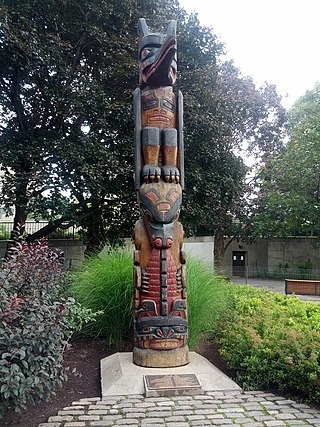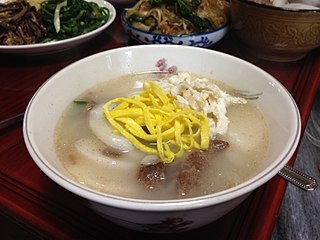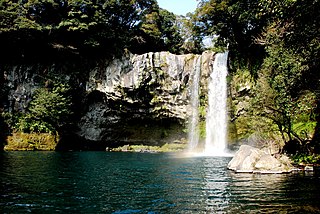Contents
- Features
- Origins of worshipping sotdae
- Components of sotdae and their meanings
- Poles and posts
- Birds
- See also
- References
- External links
Features
Sotdae were generally set up alone, but sometimes, along with jangseung (Korean totem poles), doltap (돌탑, a pagoda built with stone) or sinmok (신목, sacred trees). It was worshiped as a village guardian. The birds may look like wild geese, crows or ibises in some areas, but ducks are the most common. [3] [6] Sotdae have different names according to regions; soju (소주), sojutdae (소줏대) in Jeolla Province, soldae (솔대) in Gangwon Province and Hamhung district, [5] byeolsindae (별신대) in coastal areas of Gyeongsang Province, and sotdaek (솟댁) in Hwanghae and Pyeongan Province. Pyojutdae (표줏대), georitdae (거릿대), susalmok (수살목) and seonangdae (선앙대) are other names. [2]
Nothing precise is known about the sotdae's origin. However, sotdae was believed to be sanctified as a village guardian from when people started agriculture and the unit of society formed based on agricultural villages. [4] Later, as a concept of feng shui prevailed and values of success and honour became important, its meaning seemed to be differentiated from an object of worship to a totem for abundant harvest. [7] Ducks, as migratory birds, had various religious symbols and made the meanings of sotdae more diverse. [3]
Origins of worshipping sotdae
The worship of sotdae-like objects was commonly found in North Asia. [7] Figures or patterns on Bronze Age relics that included a pole with a bird on it were discovered around these areas. As people began to develop techniques for metalworking and increased their agriculture production, power differences among tribes emerged. Dominating class sought a political and religious foundation needed to maintain their powers from gods in the heaven. [8] [9] So it was assumed that appearance of sotdae stemmed from the integration between "Cosmic Tree" and "Sky-Birds". [8] [9]
A similar sacred pole is found among the Omaha tribe of the central United States.
Components of sotdae and their meanings
Poles and posts
Poles and posts have religious and symbolic meanings around the world. Poles of sotdae are related to 'the world-axis'. There are three cosmic levels in the concept of the universe in Northern Asian shamanism — upper, middle, and lower level. They are connected to each other by the world-axis. [8] A tree has roots extending into the earth and also grows toward the sky, which could be a symbol for the world-axis. So the wooden poles or posts were possibly considered to be a pathway for spiritual beings to come down to earth and they became a sacred object to worship by themselves. [8] A similar record was found in a book titled Dongguksesigi (동국세시기, 東國歲時記), which said that 12 wooden poles were set up to welcome a god on February 2 in Jeju island. [10] Also Dangun 's father, Hwanung, descended from the heaven to the top of a tree, Sindansu (신단수, 神壇樹) in Korea's founding myth. [11] People selected a tree which was beyond the reach of humans and they conducted ceremonial rites before they cut down the tree. On top of that, the poles and posts were believed to offer protection a village against calamities and disasters and also acted like a mast in a U-shaped land area balancing and making the land stable. [12]
Birds
Sotdae birds may be wild geese, gulls, ibises, Korean magpies or crows, but most commonly they are ducks. [3] Ducks give an important symbolic meaning to sotdae. They are able to travel on water as well as on land and in the air and also can go under water. Because of the relation to water, ducks were regarded to have an ability to control rain and thunder, to survive in the floods and to protect a village from fire. This belief made people think of ducks as a guardian in ancient agricultural societies. [3] [8] [9] Relating to this, a scholar named Lee Gyubo (이규보, 李奎報 1168–1241) wrote a following phrase in his garland called Donggukisanggukjip (동국이상국집, 東國李相國集: Collected works of Minister Yi of Korea): "Because of the rain for 7 days in a row, the capital of Songyang was submerged. The king, Jumong, was riding a duck horse stretching a reed rope across the river and his people were all holding that rope." This suggests that people considered a duck as a rescuer from flood. [6]
Another characteristic of ducks is that they are migratory birds coming to Korea in autumn. Migratory birds appear and disappear on a regular basis and it was believed that ducks travel to the world beyond the Earth and act as a messenger between the physical world and the realm of the spirits. In agriculture, this periodicity might be associated with the cycle of monsoon which brings rain. Also, the fact that ducks are fertile species and lay bigger eggs than chickens do would be a good reason for ducks to be an idolized object representing abundance. [3]
Meaning of the number of birds and their direction
The shape of birds on sotdae was carved as minutely as possible but it was sometimes simplified to just Y or ㄱ shape. The number of birds seated on sotdae was different from village to village, from one to three. Commonly one bird was seated on a pole, but sometimes two or three birds on a Y-shape branch were found on a pole — either facing each other or facing the same direction. Nothing is exactly known concerning the number of birds but it is assumed that the number of birds on a pole was decided according to the number of places which 'qi' should be complemented. [8] The direction of the bird's heads varies. People made sotdae erected toward south to wish moderate weather for farming or let it direct north to bring rain. Sometimes sotdae turned toward the outside of the village to make sure that ducks take all the evil spirits and fly away. [8] [9]
See also
Related Research Articles

Totem poles are monumental carvings found in western Canada and the northwestern United States. They are a type of Northwest Coast art, consisting of poles, posts or pillars, carved with symbols or figures. They are usually made from large trees, mostly western red cedar, by First Nations and Indigenous peoples of the Pacific Northwest Coast including northern Northwest Coast Haida, Tlingit, and Tsimshian communities in Southeast Alaska and British Columbia, Kwakwaka'wakw and Nuu-chah-nulth communities in southern British Columbia, and the Coast Salish communities in Washington and British Columbia.

The wood duck or Carolina duck is a partially migratory species of perching duck found in North America. The male is one of the most colorful North American waterfowls.

The mandarin duck is a perching duck species native to the East Palearctic. It is sexually dimorphic, with males showing a dramatic difference from the females. It is medium-sized, at 41–49 cm (16–19 in) long with a 65–75 cm (26–30 in) wingspan. It is closely related to the North American wood duck, the only other member of the genus Aix. 'Aix' is an Ancient Greek word which was used by Aristotle to refer to an unknown diving bird, and 'galericulata' is the Latin for a wig, derived from galerum, a cap or bonnet. Outside of its native range, the mandarin duck has a large introduced population in the British Isles and Western Europe, with additional smaller introductions in North America.

Jeju Province, officially Jeju Special Self-Governing Province, is the southernmost province of South Korea, consisting of eight inhabited and 55 uninhabited islands, including Mara Island, Udo Island, the Chuja Archipelago, and the country's largest island, Jeju Island. The province is located in the Korea Strait, with the Korean Peninsula to the northwest, Japan to the east, and China to the west. The province has two cities: the capital Jeju City, on the northern half of the island and Seogwipo, on the southern half of the island. The island is home to the shield volcano Hallasan, the highest point in South Korea. Jeju and Korean are the official languages of the province, and the vast majority of residents are bilingual.

A totem is a spirit being, sacred object, or symbol that serves as an emblem of a group of people, such as a family, clan, lineage, or tribe, such as in the Anishinaabe clan system.

The knob-billed duck or African comb duck is a type of duck found along the tropical/sub-tropical wetlands and waterways of Sub-Saharan Africa and the island of Madagascar, as well as most of South Asia and mainland Indochina.

Stories and practices that are considered part of Korean folklore go back several thousand years. These tales derive from a variety of origins, including Shamanism, Confucianism, Buddhism, and more recently Christianity.

A Bisj, Mbis or Bis pole is a ritual artifact created and used by the Asmat people of South-western New Guinea, Indonesia. They are also common in New Zealand, Vanuatu.

Tteokguk (Korean: 떡국) or sliced rice cake soup is a traditional Korean dish eaten during the celebration of the Korean New Year. The dish consists of the broth/soup (guk) with thinly sliced rice cakes (tteok). Eating tteokguk on New Year's Day is traditionally believed to grant good luck for the year and confer one sal. It is usually garnished with thin julienned cooked eggs, marinated meat, gim (김), and sesame oil (참기름).

H5N8 is a subtype of the influenza A virus and is highly lethal to wild birds and poultry. H5N8 is typically not associated with humans. However, seven people in Russia were found to be infected in 2021, becoming the first documented human cases.

Waterfowl hunting is the practice of hunting aquatic birds such as ducks, geese and other waterfowls or shorebirds for food and sport.

Cheonjiyeon Waterfall (Korean: 천지연폭포) is a waterfall on Jeju Island, South Korea. It is 22 m (72 ft) high and 12 m (39 ft) wide. It is one of the main tourist attractions on Jeju, particularly when they are illuminated at night time. At night, the "Hidden Face," a formation of rocks, may be visible with the night lights.

A dol hareubang, alternatively tol harubang, hareubang or harubang, is a type of traditional volcanic rock statue from Jeju Island, Korea.

A jangseung (Korean: 장승) or village guardian is a Korean totem pole usually made of wood. Jangseungs were traditionally placed at the edges of villages to mark village boundaries and frighten away demons. They were also worshipped as village tutelary deities.

Tangpyeong-chae or mung bean jelly salad is a Korean dish that was part of the Korean royal court cuisine. It is made by mixing julienned nokdumuk, mung bean sprouts, water dropwort, stir-fried shredded beef, thinly shredded red pepper and lightly broiled gim. Tangpyeongchae is seasoned with a sauce made with ganjang, vinegar, sugar, sesame seeds and sesame oil. The dish is most often eaten in late spring and summer.
Asur people are a very small Austroasiatic ethnic group living primarily in the Indian state of Jharkhand, specifically within the Gumla, Lohardaga, Palamu, and Latehar districts. They speak Asur, a Munda language.

Samseonggung is a shrine along the slopes of Jiri Mountain, Hadong County in South Gyeongsang Province that was created for paying homage to the three mythical founders of Korea:
The wildlife of Korea belongs to the Palearctic realm. Native or endemic species of the Korean Peninsula include Korean hare, Korean water deer, Korean field mouse, Korean brown frog, Korean pine and Korean spruce. The Korean Demilitarized Zone (DMZ) with its forest and natural wetlands is a unique biodiversity spot, which harbours 82 endangered species such as the red-crowned crane, Amur leopard and the Siberian tiger. Overall, DMZ is home to about 70 mammalian species, more than 300 birds and about 3,000 plants.
A ceremonial pole is a stake or post utilised or venerated as part of a ceremony or religious ritual. Ceremonial poles may symbolize a variety of concepts in different ceremonies and rituals practiced by a variety of cultures around the world.

Bangsatap are traditional ritual doldam piles on Jeju Island, in Jeju Province, South Korea. These piles are meant to ward off evil spirits. They are now seen as cultural symbols of Jeju.
References
- ↑ Randolph E. Schmid (2007-07-07). "Smithsonian to Open Korea Gallery". The Washington Post . Retrieved 2008-07-14.
- 1 2 "Totem Pole Park (Sotdae and Jangseung Park)". The official stie of Hampyeong County. Retrieved 2008-07-14.
- 1 2 3 4 5 6 7 Gary Rector (2002-09-06). "(HEUNGBO'S GOURD)Sotdae - a symbol worth saving". JoongAng Daily . Retrieved 2008-07-14.
- 1 2 3 "Sotdae 솟대" (in Korean). Empas / EncyKorea . Retrieved 2008-07-14.
- 1 2 "Sotdae 솟대" (in Korean). Doosan Encyclopedia . Retrieved 2008-07-14.
- 1 2 "Sotdae: Embodying Wishes for Prosperity". Korean Overseas Information Service. Retrieved 2008-07-14.
- 1 2 "Sotdae (솟대)" (in Korean). Empas / Britannica . Retrieved 2008-07-14.
- 1 2 3 4 5 6 7 Lee, Pil-yeong, Sotdae
- 1 2 3 4 "Part 11. Sotdae: Duck, could you send a message to the heaven regarding our dream? (11편 솟대 : 오리야, 우리 꿈을 하늘에 전해주렴)" (in Korean). Busan Cultural Tourism Guiders Association (부산문화관광해설사회). Retrieved 2008-07-14.
- ↑ Prof. Jang Deok-ji (장덕지 교수) (2006-08-09). "The legends, myths, folklores related Jeju horse 3(제주마와 관련된 신화ㆍ전설 및 민속 등 III)" (in Korean). Jeju Times. Retrieved 2008-07-14.
동국여지승람(東國與地勝覽)과 동국세시기(東國歲時記)에는 제주목(濟州牧)편에 이에 관한 기록이 있다. 2월 초하룻날 귀덕, 김녕 등지에서는 나뭇대 12개를 세워 신을 맞이하여 제사를 지낸다.
- ↑ ÀïÁ¡1È
- ↑ 1⁄4Ú'ë
- Lee, Pil-yeong (이필영) (1990). Sotdae (솟대) (in Korean). Daewonsa. ISBN 89-369-0015-3.
- The National Academy of the Korean Language (2002). Illustrated Guide to Korean Culture; 233 traditional keywords . Hakgojae. ISBN 89-85846-98-1.
- National Institute of Korean History (2002). Korean History (in Korean). Ministry of Education & Human Resources Development.
- "Cultural Symbols". The Overseas Koreans Foundation. Archived from the original on 2008-12-22. Retrieved 2008-07-14.
External links
Text is available under the CC BY-SA 4.0 license; additional terms may apply.
Images, videos and audio are available under their respective licenses.
| Sotdae | |
 Sotdae |